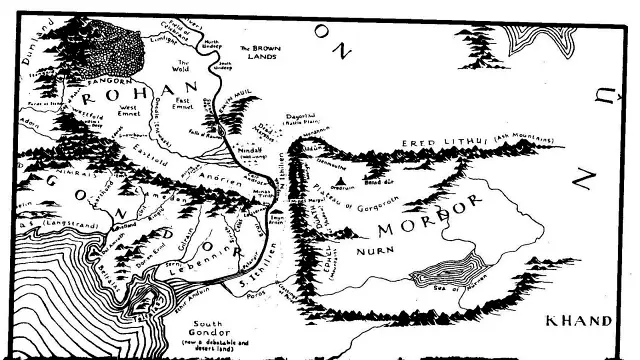Unlocking the Secrets of Mordor’s Economy!
When diving into the world of J.R.R. Tolkien, one can’t help but be captivated by the intricate details of Middle-earth. As I researched towers for my upcoming book, I found myself pondering the economy of Mordor. While Tolkien excelled in crafting languages and histories, his geographical and economic insights leave much to be desired.
A Land of Isolation
Mordor is a landlocked region, bordered by imposing mountain ranges on three sides. To the northwest lies the Plateau of Gorgoroth, a dry and cold area, possibly volcanic, with no rivers flowing from it. To the southeast, the Sea of Nurnen offers little solace, as it is low-lying and bitter. The only river of note, the Harnen, starts just outside Mordor’s southern border. The Great River Anduin flows tantalizingly close to Mordor’s western edge, but only two passes through the Ephel Duath allow access: Minas Morgul and the Morannon, or “Black Gate.”
Limited Trade Opportunities
Given its geography, trade routes from Mordor are scarce. To the east, the land is open, but the Easterlings and Wainriders—Mordor’s allies—are depicted as wild nomadic tribes, not reliable suppliers. South Gondor is marked as a “debatable or desert land,” while regions like Near Harad, Haradwaith, and Khand appear devoid of resources. It raises the question: how do the Southrons muster the resources to support their vast armies?
A Desolate Landscape
Mordor is an ecologist’s nightmare. The land is a wasteland of ash and slag, riddled with fissures and rocky ridges. At its center stands the Dark Tower, overseen by the all-seeing Eye, not far from an active volcano that spews ash and smoke. The environment is hostile—little rain falls, and any water that trickles through becomes poisoned.
The Orcs’ Dilemma
In a moment of doubt, Samwise Gamgee questions whether orcs eat or drink. Frodo reassures him that orcs do consume food, albeit “foul waters and foul meats.” This raises an important point: armies march on their stomachs. While the Dark Lord Sauron and the Nine Ringwraiths may not care about food supplies, what about the orcs? Why do they serve a master in a barren land with no agriculture or trade?
The Question of Loyalty
Frodo observes armies marching into Mordor, comprised of “men of other race, out of the wide Eastlands.” What motivates these individuals to rally behind a Dark Lord ruling a bankrupt nation? If Gondor falls, it would likely become a wasteland too, leaving no promise of future riches.
A Flawed Economic Model
In a typical economy, Mordor would be drowning in debt. Refugees—be they orcs, Easterlings, or Southrons—would be fleeing westward, seeking better lives in Gondor. Instead of fortifying against invaders, Minas Tirith would be welcoming immigrants. Orcs would likely seek work as cheap labor, and the Rohirrim would patrol their borders to prevent an influx of refugees. Even a Dark Lord would need to borrow from the wealth of Minas Tirith or the dwarves to sustain his realm.
A Simplified Narrative
However, “The Lord of the Rings” is not a political satire. Tolkien’s world is polarized: the brave and good stand against the wicked and cruel. Perhaps we should be thankful that Tolkien didn’t delve too deeply into Mordor’s economy. It allows us to focus on the epic struggle between good and evil without getting bogged down in economic realities.
Conclusion: The Power of Imagination
In the end, Mordor serves as a backdrop for the grand narrative of Middle-earth. While its economy may be flawed, the story it helps tell is timeless. So, let’s celebrate the Dark Lord, the Ruler of the Wastelands, and the Commander of the Ringwraiths. Just remember, he’s a fictional character, and his world is a product of imagination.

